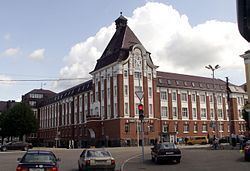Coat of arms Flag Town of district significance Gusev Local time Sunday 5:55 AM | Area 16.25 km² | |
 | ||
Weather 2°C, Wind NE at 11 km/h, 93% Humidity | ||
Gusev (Russian: Гу́сев), previously known by its German name Gumbinnen (Lithuanian: Gumbinė; Polish: Gąbin), is a town and the administrative center of Gusevsky District of Kaliningrad Oblast, Russia, located at the confluence of the Pissa and Krasnaya Rivers, near the border with Poland and Lithuania, east of Chernyakhovsk. Population: 28,260 (2010 Census); 28,467 (2002 Census); 27,031 (1989 Census).
Contents
- Map of Gusev Kaliningradskaya Oblast Russia
- History
- Administrative and municipal status
- Transportation
- The Yantar Special Economic Zone
- Notable people
- Twin towns and sister cities
- References
Map of Gusev, Kaliningradskaya Oblast, Russia
History
The settlement of Gumbinnen (from Lithuanian: Gumbinė: tuber) in the Duchy of Prussia was first mentioned in a 1580 deed. The settlement had been laid out at the behest of the Hohenzollern duke Albert of Prussia in 1545.
In 1709-1711, the area was devastated by the plague and had to be redeveloped under the rule of King Frederick William I of Prussia. He granted Gumbinnen town privileges in 1724 and from 1732 resettled the area with Protestant expellees from the Archbishopric of Salzburg, who had been exiled by Prince-Archbishop Count Leopold Anton von Firmian. A first church of the Salzburg Protetants was erected in 1752 and rebuilt according to plans by Karl Friedrich Schinkel in 1840.
From 1815, the town was the capital of Regierungsbezirk Gumbinnen administrative district in the Province of East Prussia. Gumbinnen became a part of the German Empire during the unification of Germany in 1871. After the Prussian State railway line from Königsberg to Stallupönen (now Nesterov) was built through Gumbinnen in 1860, the town grew in economic importance. By the end of the 19th century, Gumbinnen had a foundry, a machine shop, a furniture factory, a clothing mill, two sawmills, several brickworks, and a dairy.
The Battle of Gumbinnen, a major battle on the Eastern Front of World War I, took place nearby in the opening days of the war in August 1914, and the town was occupied by the Russian Army for several months. After the war, a power plant, the Ostpreußenwerk, was built in Gumbinnen that served much of East Prussia.
After Adolf Hitler and the Nazis came to power, the German government designated Gumbinnen as a military sub-region of the Königsberg military area. Near the end of World War II, in 1944, the first of Gumbinnen's 24,000 residents began to flee from the advancing Red Army, which was drawing close. A Soviet air attack on October 16, 1944, caused heavy damage to the inner city. On October 22, 1944, the town was taken by Soviet forces. In the two days before the Wehrmacht re-took it, vengeful Red Army troops engaged in numerous atrocities against the civilian population. Although German forces managed in late October to stabilize the battle line east of Gumbinnen, the town was quickly re-conquered by the Red Army during the great Soviet offensive on 21 January 1945. The surviving German residents fled or were forcibly expelled.
Under border changes promulgated at the Potsdam Conference in 1945, northern East Prussia, including Gumbinnen, became a part of the Soviet Union and the town’s name was changed to Gusev, in honor of a Red Army captain, Sergei Ivanovich Gusev, who was killed in action near Gumbinnen in January 1945. Gusev posthumously was awarded the title Hero of the Soviet Union on April 19, 1945.
Administrative and municipal status
Within the framework of administrative divisions, Gusev serves as the administrative center of Gusevsky District. As an administrative division, it is incorporated within Gusevsky District as the town of district significance of Gusev.
Within the framework of municipal divisions, since June 10, 2013, the territories of the town of district significance of Gusev and of four rural okrugs of Gusevsky District are incorporated as Gusevsky Urban Okrug. Before that, the town of district significance was incorporated within Gusevsky Municipal District as Gusevskoye Urban Settlement.
Transportation
Gusev lies on the double-track, broad-gauge rail line connecting the Kaliningrad Oblast, a Russian exclave since 1991, with the main territory of Russia, through Lithuania and Belarus.
The Yantar Special Economic Zone
In the 1990s in Kaliningrad Oblast was established The Yantar Special Economic Zone. Some of the zone's projects are located in Gusev, e.g. NPO CTS.
Notable people
Twin towns and sister cities
Gusev is twinned with:
